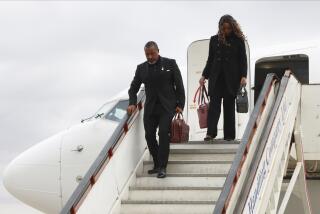At Least 9 Survive Crash of Kenya Jet Off Africa With 179 Aboard
ABIDJAN, Ivory Coast — A Kenya Airways jet carrying 169 passengers and 10 crew members crashed into the sea Sunday night, shortly after takeoff from Abidjan. At least eight people were pulled from the water alive, officials said, and one man swam to shore.
“He was a good swimmer. That’s how he managed to survive,” said Dr. Tanoh Koutoua, who treated the man, who was only identified as being French.
The plane, an Airbus 310, took off at 9:08 p.m. for Lagos, Nigeria, and crashed into the Atlantic Ocean one minute later, said George Dapre Yao, the head of air traffic at Abidjan’s Felix Houphouet-Boigny Airport.
Samuel Ogbada Adje, a Nigerian who was rescued at sea, said the plane started having problems as soon as it took off.
“It wasn’t quite balanced, and the next thing we knew we were in the water,” said Adje, wrapped in a blanket at an Abidjan port.
He said the rescue effort had been a disaster.
“If they had come sooner, a lot of us would have been saved. We waited two hours for people to rescue us,” he said angrily before being pushed into an ambulance and driven away.
In Nairobi, Kenya, the U.S. Embassy said there was an American on the flight but did not know whether he was among the survivors. He was not identified.
Steve Clarke, the technical director of Kenya Airways, said the plane took off from Nairobi but could not make its scheduled landing in Lagos because of bad weather. The problem this time of year in West Africa is related to a phenomenon known as the harmattan--sand blown south from the Sahara Desert and the Sahel.
Most of the passengers would have left the plane before it crashed if weather had not forced it to overfly Lagos, airline officials said.
Six or seven survivors were found early today floating in the wreckage and were being taken to an area hospital, said Raymond Kesse, an official with Ivory Coast’s Red Cross.
At least two more survivors were seen being brought ashore at a port a few miles from the crash scene. One woman, blood pouring out of a head wound, was brought in by the owner of a fishing boat.
“We were really lucky to find her,” said Gerard Frere. “She was clutching on to debris.”
He said the crash site, between three and four miles offshore, was a chaotic scene.
“We went out here and there, we had no light. We had to improvise,” he said. “There are bodies floating everywhere, ripped-off arms and lots of debris.”
Witnesses said the plane never appeared to gain sufficient altitude as it flew over a wall at the runway’s edge and headed out over the ocean, just a few hundred yards away.
“I saw it take off,” said an itinerant trader who identified himself as Alogouleta. “After it went over the wall, it was still very low. Then it hit the water. I heard the sound two times” as the plane slammed into the ocean.
“It broke up on impact. It broke into 100 pieces,” said Alain Thonar, a medical worker at the airport.
Some witnesses reported hearing bangs as the plane went down. “There were three loud explosions,” Thonar said, quoting witnesses from the beach. Other witnesses spoke of seeing lights at the surface before the plane sank.
By dawn today, it was not clear if anyone on the plane was still alive. At least 14 bodies had been found.
More to Read
Sign up for Essential California
The most important California stories and recommendations in your inbox every morning.
You may occasionally receive promotional content from the Los Angeles Times.










